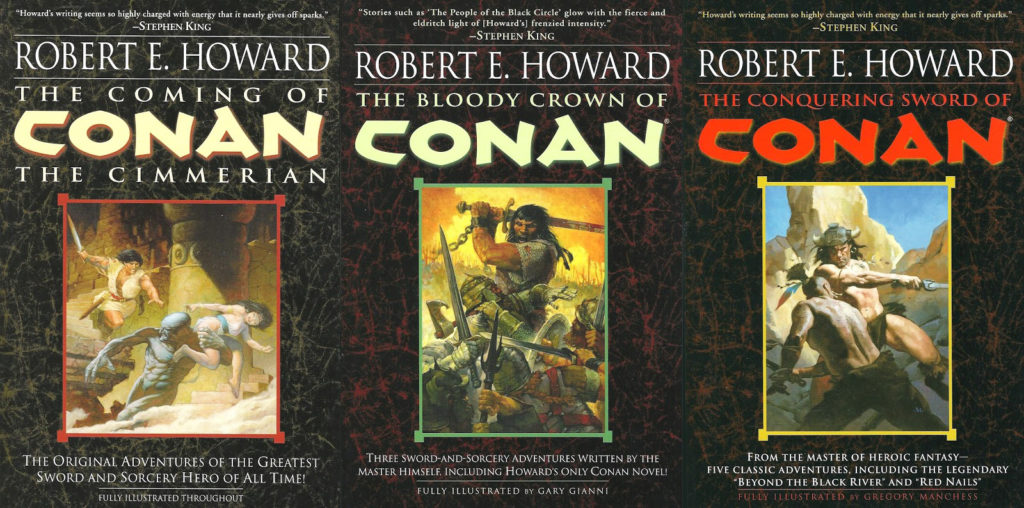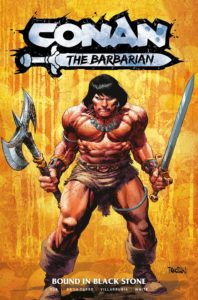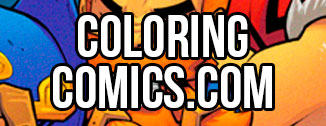Continuing my Conan reread for Cimmerian September, the seventh published Conan story is Rogues in the House, which arrived in the January 1934 issue of Weird Tales magazine.
This story sets up characters and motivations in the first chapter and Conan is just one of several moving pieces, which works quite well despite the fact that the opening reads like a recap of a story we missed instead of the current narrative.
In four terse paragraphs, we’re told about a Red Priest named Nabonidus who threatens an aristocrat named Murilo, and Murilo deciding that the only assassin he can trust to take out Nabonidus in this corrupt city is an outsider – an imprisoned barbarian named Conan who was arrested after killing a different priest who betrayed him. With the preamble taken care of, we go to the prison as Murilo negotiates with our Cimmerian:
To this cell came Murilo, masked and wrapped in a wide black cloak. The Cimmerian surveyed him with interest, thinking him the executioner sent to dispatch him. Murilo set him at rights and regarded him with no less interest. Even in the dim light of the dungeon, with his limbs loaded with chains, the primitive power of the man was evident. His mighty body and thick-muscled limbs combined the strength of a grizzly with the quickness of a panther. Under his tangled black mane his blue eyes blazed with unquenchable savagery.
“Would you like to live?” asked Murilo. The barbarian grunted, new interest glinting in his eyes.
There’s a great line where it’s once again made clear that Conan isn’t a “hero” in the classic sense, but always a protagonist – Always at the center of interesting events that drive the plot:
The Cimmerian showed no sign of surprise or perturbation. He had none of the fear or reverence for authority that civilization instills in men. King or beggar, it was all one to him.
After bribing a prison guard so Conan can escape, complications arise. It looks like Conan won’t be set free after all, so Murilo curses his luck, grabs his blade, and quietly breaks into Nabonidus’ estate so he can try to kill the Red Priest himself…But he doesn’t know there’s already another attack underway and he’s been thrust into the middle of it. The chapter ends as Murilo sees something terrifying, but the reader won’t know what that is until later.
I quite enjoy the unexpected sequence of events that roll out here. Every part of Murilo’s plan should work but doesn’t, and that chaos makes it feel more “real”. The wider world is constantly moving, changing the shape and flow of any plan these characters make. Coincidence that works in our characters’ favor can diminish the sense of challenge, whereas heaping more difficulty on them, even just bad luck, gives it more gravity.
With a bit of well-timed violence Conan springs himself out of his cell and has a choice to make:
It occurred to him that since he had escaped through his own actions, he owed nothing to Murilo; yet it had been the young nobleman who had removed his chains and had the food sent to him, without either of which his escape would have been impossible. Conan decided that he was indebted to Murilo and, since he was a man who discharged his obligations eventually, he determined to carry out his promise to the young aristocrat.
But first our barbarian needs to get a bit of vengeance against the woman who led to his arrest. As chapter two ends, he guts her new paramour and dumps the woman off a rooftop into refuse, then heads back to his original mission, not knowing that Murilo is already on site and in trouble.
Chapter three starts with Conan sneaking into the priest’s manor house through pits connected to the sewers and discovering Murilo there. The frightened aristocrat believes Nabonidus has become a terrifying beast:
“Conan,” he whispered, “it was no man that stood before me! In body and posture it was not unlike a man, but from the scarlet hood of the priest grinned a face of madness and nightmare! It was covered with black hair, from which small pig- like eyes glared redly; its nose was flat, with great flaring nostrils; its loose lips writhed back, disclosing huge yellow fangs, like the teeth of a dog. The hands that hung from the scarlet sleeves were misshapen and likewise covered with black hair. All this I saw in one glance, and then I was overcome with horror; my senses left me and I swooned.”
“What then?” muttered the Cimmerian uneasily.
“I recovered consciousness only a short time ago; the monster must have thrown me into these pits. Conan, I have suspected that Nabonidus was not wholly human! He is a demon—a were-thing! By day he moves among humanity in the guise of men, and by night he takes on his true aspect.”
And if it was as simple as that, the story could still have worked, with Conan fighting a bestial were-priest, but that’s not how events play out. Once again, there are wheels within wheels. The pair explore the pits in the dark and eventually come across another figure regaining consciousness – It’s Nabonidus! The Red Priest and the aristocrat argue about which of them is more morally bankrupt than the other, with Murilo unleashing a well articulated blast:
“You exploit a whole kingdom for your personal greed; and, under the guise of disinterested statesmanship, you swindle the king, beggar the rich, oppress the poor, and sacrifice the whole future of the nation for your ruthless ambition. You are no more than a fat hog with his snout in the trough. You are a greater thief than I am. This Cimmerian is the most honest man of the three of us, because he steals and murders openly.”
“Well, then, we are all rogues together,” agreed Nabonidus equably.
Hence the story’s title.
As the trio sneak around the house, Nabonidus finally identifies their attacker:
“That is Thak,” answered the priest, caressing his temple. “Some would call him an ape, but he is almost as different from a real ape as he is different from a real man. His people dwell far to the east, in the mountains that fringe the eastern frontiers of Zamora. There are not many of them; but, if they are not exterminated, I believe they will become human beings in perhaps a hundred thousand years. They are in the formative stage; they are neither apes, as their remote ancestors were, nor men, as their remote descendants may be.”
In quite a few of his stories, Robert E. Howard explores concepts around evolution and devolution and they’re part of the larger theme of ‘Civilization VS Savagery’ at the heart of many of Conan’s tales. Humanity is drawn to violence and other base instincts, and in this case Thak is a personification of that:
“He was at once bodyguard and servant. But I forgot that being partly a man, he could not be submerged into a mere shadow of myself, like a true animal. Apparently his semi-brain retained impressions of hate, resentment, and some sort of bestial ambition of its own.”
The rest of the story is a tense interplay with the barbarian, the priest, and the aristocrat forced to work together to neutralize Thak and escape, using strange traps Nabonidus has installed in the manor, but those aren’t enough and Conan ends up battling the beast, a sequence which gets some punchy prose:
In a whirlwind of blows and scarlet tatters they rolled along the corridor, revolving so swiftly that Murilo dared not use the chair he had caught up, lest he strike the Cimmerian. And he saw that in spite of the handicap of Conan’s first hold, and the voluminous robe that lashed and wrapped about the ape-man’s limbs and body, Thak’s giant strength was swiftly prevailing.
Mark Schultz’s illustration of Conan fighting Thak (shown above) is wonderful, and you can tell he was clearly influenced by Frank Frazetta, who immortalized the same moment in one of his classic Conan book cover illustrations:

The story ends in a swirl of blood and betrayal and, even though the prose is just over 9700 words, it feels a lot larger thanks to the way circumstances keep shifting and new complications are introduced. Rogues in the House isn’t as emotional or elegant as the finest Conan stories, but it is iconic and a heck of a lot of fun.
If you haven’t read the original Conan prose stories, I recommend the Del Rey 3-book set, which has each story unedited and essays that add context around their publication.







 Zub on Amazon
Zub on Amazon Zub on Instagram
Zub on Instagram Zub on Twitter
Zub on Twitter
I think this is my favourite Conan story. It’s certainly got the quote I think of the most when I think of Conan – “Someday, when all your civilization and science are likewise swept away, your kind will pray for a man with a sword.”